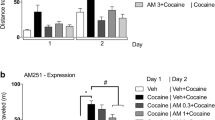Abstract
The involvement of cannabinoid processes in positive reinforcement was studied using an unbiased, one-compartment, conditioned place preference (CPP) procedure in rats. This was achieved by examining the ability of the selective antagonist of the CB1 cannabinoid receptor subtype, SR 141716, to counteract the CPP supported by classical reinforcers. The acquisition of CPP induced by cocaine (2 mg/kg), morphine (4 mg/kg) and food (standard chow and sucrose pellets) was dose-dependently blocked by pre-pairing administration of SR 141716 (0.03–3 mg/kg). However, SR 141716 (up to 10 mg/kg) did not significantly counteract the expression of cocaine-induced CPP. On the other hand, the synthetic CB receptor agonist, WIN 55212-2 (0.3–1 mg/kg), established a robust place aversion (CPA), as already described with other agonists, and CPP was never observed, even at 100-fold lower doses. The aversive effect of WIN 55212-2 was reversed by SR 141716 (0.3–1 mg/kg), suggesting that it was accounted for by the stimulation of CB1 receptors. These findings indicate that, on their own, CB receptor agonists are unable to generate the processes necessary to induce a pleasurable state in animals, as assessed in place conditioning procedures. Nevertheless, a cannabinoid link may be involved in the neurobiological events, allowing the perception of the rewarding value of various kinds of reinforcers. However, a permanent endogenous cannabinoid tone seems unlikely to be necessary to ensure the organism a basal hedonic level since, given alone, SR 141716 supported neither CPP nor CPA.
Similar content being viewed by others
Author information
Authors and Affiliations
Additional information
Received: 14 March 1997 / Final version: 28 July 1997
Rights and permissions
About this article
Cite this article
Chaperon, F., Soubrié, P., Puech, A. et al. Involvement of central cannabinoid (CB1) receptors in the establishment of place conditioning in rats. Psychopharmacology 135, 324–332 (1998). https://doi.org/10.1007/s002130050518
Issue Date:
DOI: https://doi.org/10.1007/s002130050518




